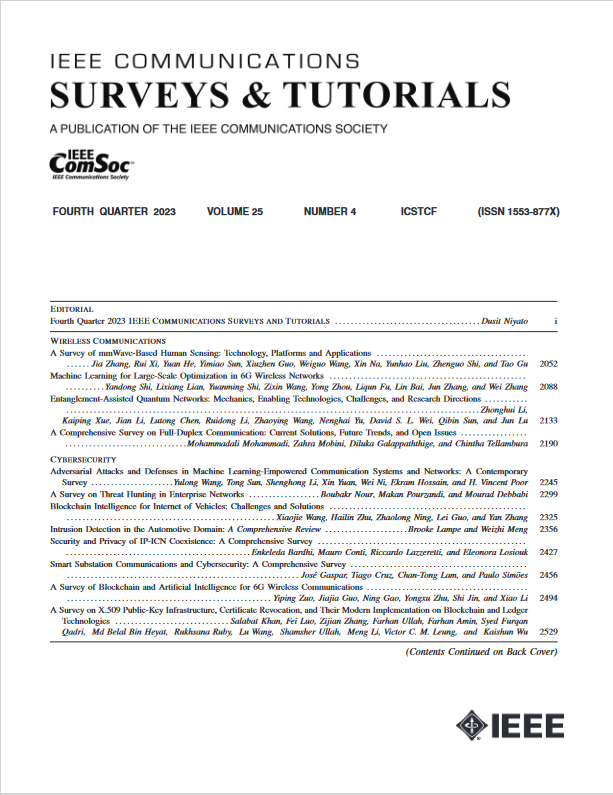The Metaverse: Survey, Trends, Novel Pipeline Ecosystem & Future Directions
IF 34.4
1区 计算机科学
Q1 COMPUTER SCIENCE, INFORMATION SYSTEMS
引用次数: 0
Abstract
The Metaverse offers a second world beyond reality, where boundaries are non-existent, and possibilities are endless through engagement and immersive experiences using the virtual reality (VR) technology. Many disciplines can benefit from the advancement of the Metaverse when accurately developed, including the fields of technology, gaming, education, art & culture, socialization, commerce, and businesses. Nevertheless, developing the Metaverse environment to its full potential is an ambiguous task that needs proper guidance and directions. Existing surveys on the Metaverse focus only on a specific aspect and discipline of the Metaverse and lack a holistic view of the entire process. Moreover, most surveys refrain from providing detailed guidance about the development process of the metaverse, including its impact on technologies, businesses, existing challenges, and potential research directions due to their lack of a macro and micro perception of such a topic. To this end, a more holistic, multi-disciplinary, in-depth, and academic and industry-oriented review is required to provide a thorough study of the Metaverse development pipeline and fill the gap in existing Metaverse surveys. To address these issues, we present in this survey a novel multi-layered pipeline ecosystem composed of (1) the Metaverse computing, networking, communications and hardware infrastructure, (2) environment digitization, and (3) user interactions. For every layer, we discuss the components that detail the steps of its development. Also, for each of these components, we examine the impact of a set of enabling technologies and empowering domains (e.g., Artificial Intelligence, Security & Privacy, Blockchain, Business, Ethics, and Social) on its advancement. In addition, we explain the importance of these technologies to support decentralization, interoperability, user experiences, interactions, and monetization. Our presented study highlights the existing challenges for each component, followed by research directions and potential solutions. To the best of our knowledge, this survey is the most comprehensive and allows users, scholars, and entrepreneurs to get an in-depth understanding of the Metaverse ecosystem to find their opportunities and potentials for contribution.元宇宙:调查、趋势、新型管道生态系统和未来方向
通过虚拟现实(VR)技术的参与和沉浸式体验,Metaverse 提供了一个超越现实的第二世界,在这个世界里,边界是不存在的,可能性是无限的。许多学科,包括技术、游戏、教育、艺术与文化、社交、商业和企业领域,都可以从 Metaverse 的发展中获益。然而,充分开发元宇宙环境的潜力是一项模糊的任务,需要正确的指导和方向。现有的 Metaverse 调查只关注 Metaverse 的某一特定方面和学科,缺乏对整个过程的整体把握。此外,由于缺乏对元数据的宏观和微观认识,大多数调查都没有对元数据的发展过程提供详细指导,包括其对技术、商业、现有挑战和潜在研究方向的影响。为此,我们需要更全面、更多学科、更深入、更面向学术界和产业界的综述,对元海外开发流程进行深入研究,填补现有元海外调查的空白。为了解决这些问题,我们在本研究中提出了一个新颖的多层管道生态系统,由以下部分组成:(1) Metaverse 计算、网络、通信和硬件基础设施;(2) 环境数字化;(3) 用户交互。我们将讨论每一层的组成部分,详细介绍其开发步骤。同时,对于其中的每一个组成部分,我们都会研究一系列赋能技术和赋能领域(如人工智能、安全与隐私、区块链、商业、伦理和社会)对其发展的影响。此外,我们还解释了这些技术在支持去中心化、互操作性、用户体验、互动和货币化方面的重要性。我们提交的研究报告强调了每个组成部分所面临的现有挑战,随后提出了研究方向和潜在解决方案。据我们所知,这份调查报告是最全面的,可以让用户、学者和企业家深入了解 Metaverse 生态系统,找到他们的机遇和贡献潜力。
本文章由计算机程序翻译,如有差异,请以英文原文为准。
求助全文
约1分钟内获得全文
求助全文
来源期刊

IEEE Communications Surveys and Tutorials
COMPUTER SCIENCE, INFORMATION SYSTEMS-TELECOMMUNICATIONS
CiteScore
80.20
自引率
2.50%
发文量
84
审稿时长
6 months
期刊介绍:
IEEE Communications Surveys & Tutorials is an online journal published by the IEEE Communications Society for tutorials and surveys covering all aspects of the communications field. Telecommunications technology is progressing at a rapid pace, and the IEEE Communications Society is committed to providing researchers and other professionals the information and tools to stay abreast. IEEE Communications Surveys and Tutorials focuses on integrating and adding understanding to the existing literature on communications, putting results in context. Whether searching for in-depth information about a familiar area or an introduction into a new area, IEEE Communications Surveys & Tutorials aims to be the premier source of peer-reviewed, comprehensive tutorials and surveys, and pointers to further sources. IEEE Communications Surveys & Tutorials publishes only articles exclusively written for IEEE Communications Surveys & Tutorials and go through a rigorous review process before their publication in the quarterly issues.
A tutorial article in the IEEE Communications Surveys & Tutorials should be designed to help the reader to become familiar with and learn something specific about a chosen topic. In contrast, the term survey, as applied here, is defined to mean a survey of the literature. A survey article in IEEE Communications Surveys & Tutorials should provide a comprehensive review of developments in a selected area, covering its development from its inception to its current state and beyond, and illustrating its development through liberal citations from the literature. Both tutorials and surveys should be tutorial in nature and should be written in a style comprehensible to readers outside the specialty of the article.
 求助内容:
求助内容: 应助结果提醒方式:
应助结果提醒方式:


